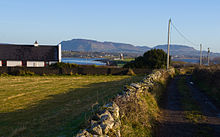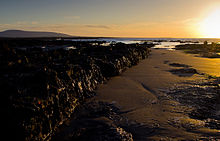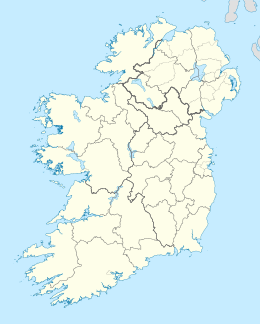Native name: Inis Uí Mhaolchluiche | |
|---|---|
 Overview from
Knocknarea | |
| Geography | |
| Location | Atlantic Ocean |
| Coordinates | 54°17′46″N 8°35′17″W / 54.2962°N 8.588°W |
| Area | 1.62 km2 (0.63 sq mi) |
| Administration | |
| Province | Connacht |
| County | Sligo |
| Demographics | |
| Population | 1 (2022) [1] |

Coney Island or Inishmulclohy ( Irish: Inis Uí Mhaolchluiche), [2] is an island between the Rosses Point and Coolera peninsulas in Sligo Bay, County Sligo, Ireland. It is one of several islands of the same name off the coast of Ireland. It is an island of approximately 400 acres and is named after the vast quantity of rabbits which can be spotted on the island at any time, the Irish for rabbit being coinín. [3] (Coney ( /ˈkoʊni/, historically /ˈkʌni/) was an English word for a rabbit or rabbit hair, with both words originally deriving from the Latin cuniculus, meaning "rabbit").
History
In 1862 the island had a population of 124 people, with 45 children attending the local school. The island now has only one family of permanent inhabitants (traceable back to the 1750s) but has many other temporary residents, especially in the summer months. [4] The island gained electricity in 1999 via an underground cable. [5]
Demographics
|
|
| |||||||||||||||||||||||||||||||||||||||||||||||||||||||||||||||||||||||||||||||||||||||
| Sources: [6] [7] [1] | |||||||||||||||||||||||||||||||||||||||||||||||||||||||||||||||||||||||||||||||||||||||||
Activities

Visitors to Coney Island like to frequent the local pub, spot the faerie ring and Napoleonic star shaped forts, visit Carty’s strand (the secluded beach to the rear of the island) for a swim or walk around the island to spot rabbits or the schoolhouse and other famine structures which remain. [4]
Folklore
There are also stories of faeries, mermaids and spirits on Coney Island, and visitors can try to find the elusive St Patrick's wishing chair, St Patrick's well, the remains of a washed up whale and some fairy forts. [4]
In the late 1700s, the merchant ship Arethusa sailed the route between Sligo and New York City. Regarding the naming of New York's Coney Island: one theory is that the ship's captain named that island after Sligo's Coney Island. [8]
Access
Coney Island is accessible by boat from Rosses Point, or by driving or walking over the causeway, two and a half kilometres across Cummeen Strand, guided by 14 pillars, at low tide. The bollards were constructed in the mid-1800s, lining up with the Black Rock lighthouse, to aid in night time travel across the bay. A spate of drowning tragedies in the 1800s, including that of the then owner of the island, William Dorrin, in 1823, prompted the construction of the bollards. [9]
See also
References
- ^ a b Population of Inhabited Islands Off the Coast (Report). Central Statistics Office. 2023. Retrieved 29 June 2023.
- ^ "Inis Uí Mhaolchluiche/Inishmulclohy or Coney Island". Placenames Database of Ireland. Government of Ireland - Department of Arts, Heritage and the Gaeltacht and Dublin City University. Retrieved 1 October 2018.
- ^ "Rabbit - Translation to Irish Gaelic with audio pronunciation of translations for rabbit by New English-Irish Dictionary".
- ^ a b c Discoverireland.ie - Coney Island
- ^ Moran, Michael. "Sligo Champion, April 1999". Archived from the original on 16 February 2013.
- ^ "Our Living Islands – National Islands Policy 2023-2033" (PDF). Department of Rural and Community Development. June 2023. p. 82. Retrieved 22 June 2023.
- ^ "CNA17: Population by Off Shore Island, Sex and Year". Census 2016. Central Statistics Office (Ireland). Retrieved 12 October 2016.
- ^ McGowan, Joe (2015). Sligo Folk Tales. The History Press. p. 78. ISBN 9780750965552.
- ^ McGoldrick, Seamus. History of Cummeen Strand

